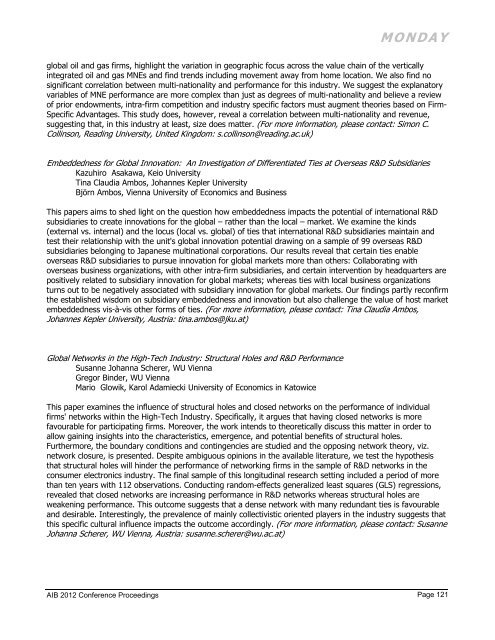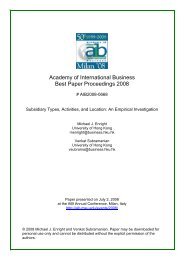AIB 2012 Conference Proceedings - Academy of International ...
AIB 2012 Conference Proceedings - Academy of International ...
AIB 2012 Conference Proceedings - Academy of International ...
Create successful ePaper yourself
Turn your PDF publications into a flip-book with our unique Google optimized e-Paper software.
MONDAY<br />
global oil and gas firms, highlight the variation in geographic focus across the value chain <strong>of</strong> the vertically<br />
integrated oil and gas MNEs and find trends including movement away from home location. We also find no<br />
significant correlation between multi-nationality and performance for this industry. We suggest the explanatory<br />
variables <strong>of</strong> MNE performance are more complex than just as degrees <strong>of</strong> multi-nationality and believe a review<br />
<strong>of</strong> prior endowments, intra-firm competition and industry specific factors must augment theories based on Firm-<br />
Specific Advantages. This study does, however, reveal a correlation between multi-nationality and revenue,<br />
suggesting that, in this industry at least, size does matter. (For more information, please contact: Simon C.<br />
Collinson, Reading University, United Kingdom: s.collinson@reading.ac.uk)<br />
Embeddedness for Global Innovation: An Investigation <strong>of</strong> Differentiated Ties at Overseas R&D Subsidiaries<br />
Kazuhiro Asakawa, Keio University<br />
Tina Claudia Ambos, Johannes Kepler University<br />
Björn Ambos, Vienna University <strong>of</strong> Economics and Business<br />
This papers aims to shed light on the question how embeddedness impacts the potential <strong>of</strong> international R&D<br />
subsidiaries to create innovations for the global – rather than the local – market. We examine the kinds<br />
(external vs. internal) and the locus (local vs. global) <strong>of</strong> ties that international R&D subsidiaries maintain and<br />
test their relationship with the unit's global innovation potential drawing on a sample <strong>of</strong> 99 overseas R&D<br />
subsidiaries belonging to Japanese multinational corporations. Our results reveal that certain ties enable<br />
overseas R&D subsidiaries to pursue innovation for global markets more than others: Collaborating with<br />
overseas business organizations, with other intra-firm subsidiaries, and certain intervention by headquarters are<br />
positively related to subsidiary innovation for global markets; whereas ties with local business organizations<br />
turns out to be negatively associated with subsidiary innovation for global markets. Our findings partly reconfirm<br />
the established wisdom on subsidiary embeddedness and innovation but also challenge the value <strong>of</strong> host market<br />
embeddedness vis-à-vis other forms <strong>of</strong> ties. (For more information, please contact: Tina Claudia Ambos,<br />
Johannes Kepler University, Austria: tina.ambos@jku.at)<br />
Global Networks in the High-Tech Industry: Structural Holes and R&D Performance<br />
Susanne Johanna Scherer, WU Vienna<br />
Gregor Binder, WU Vienna<br />
Mario Glowik, Karol Adamiecki University <strong>of</strong> Economics in Katowice<br />
This paper examines the influence <strong>of</strong> structural holes and closed networks on the performance <strong>of</strong> individual<br />
firms' networks within the High-Tech Industry. Specifically, it argues that having closed networks is more<br />
favourable for participating firms. Moreover, the work intends to theoretically discuss this matter in order to<br />
allow gaining insights into the characteristics, emergence, and potential benefits <strong>of</strong> structural holes.<br />
Furthermore, the boundary conditions and contingencies are studied and the opposing network theory, viz.<br />
network closure, is presented. Despite ambiguous opinions in the available literature, we test the hypothesis<br />
that structural holes will hinder the performance <strong>of</strong> networking firms in the sample <strong>of</strong> R&D networks in the<br />
consumer electronics industry. The final sample <strong>of</strong> this longitudinal research setting included a period <strong>of</strong> more<br />
than ten years with 112 observations. Conducting random-effects generalized least squares (GLS) regressions,<br />
revealed that closed networks are increasing performance in R&D networks whereas structural holes are<br />
weakening performance. This outcome suggests that a dense network with many redundant ties is favourable<br />
and desirable. Interestingly, the prevalence <strong>of</strong> mainly collectivistic oriented players in the industry suggests that<br />
this specific cultural influence impacts the outcome accordingly. (For more information, please contact: Susanne<br />
Johanna Scherer, WU Vienna, Austria: susanne.scherer@wu.ac.at)<br />
<strong>AIB</strong> <strong>2012</strong> <strong>Conference</strong> <strong>Proceedings</strong><br />
Page 121

















